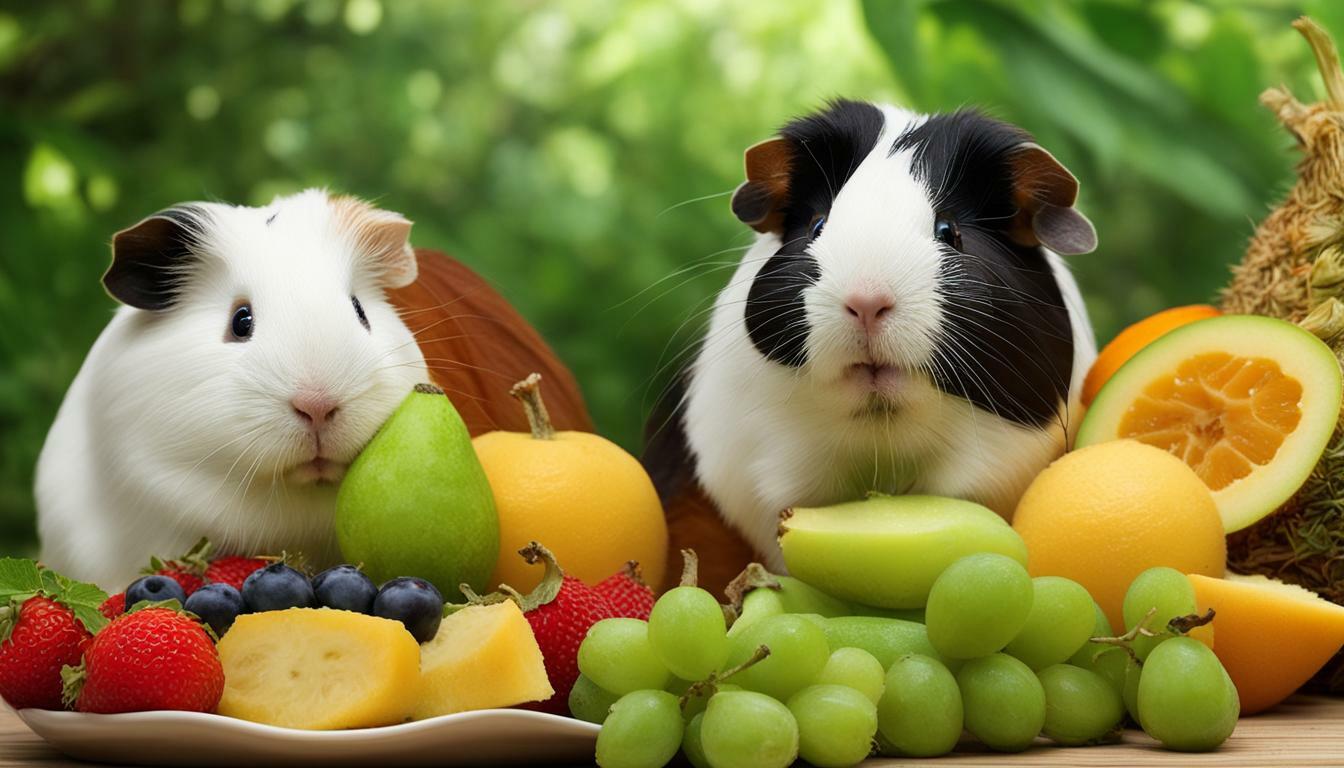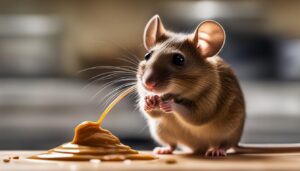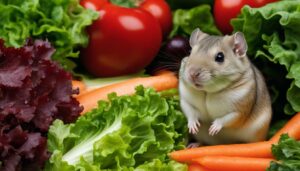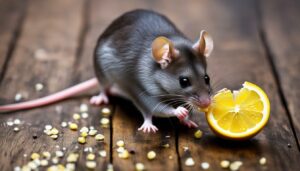Many guinea pig owners wonder if it’s safe to feed their furry friends honeydew melon. In this guide, we will explore the pros and cons of including honeydew in a guinea pig’s diet.
Key Takeaways:
- Honeydew melon can be safely consumed by guinea pigs in moderation.
- It contains essential vitamins and minerals like vitamin C, vitamin A, and potassium.
- However, it should only be offered occasionally due to its high sugar content.
- Guinea pigs can eat the flesh and skin of honeydew melon but not the seeds.
- Thoroughly wash the melon and remove any pesticides before feeding it to guinea pigs.
- Start with a small piece when introducing honeydew melon to a guinea pig’s diet and monitor their reaction.
- Serving size should be a small cube, offered as a treat once a week.
- Maintain a balanced diet by providing a variety of other fruits, vegetables, hay, and pellets for guinea pigs.
The Nutritional Benefits of Honeydew for Guinea Pigs
Honeydew melon is a nutritious treat for guinea pigs, providing them with essential vitamins and minerals that support their well-being.
This juicy fruit is rich in vitamin C, which is crucial for their immune system and overall health. It also contains vitamin A, which promotes good vision and skin health in guinea pigs.
Additionally, honeydew melon is a good source of potassium, an important mineral that helps regulate their blood pressure and fluid balance.
When feeding honeydew melon to guinea pigs, it’s important to offer it in moderation due to its high sugar content.
While the natural sugars in honeydew melon can provide a tasty treat for guinea pigs, excessive consumption can lead to health issues like obesity and diabetes.
To avoid these risks, it’s recommended to offer honeydew melon as an occasional treat, rather than a regular part of their diet.
Guinea pigs can enjoy both the flesh and skin of honeydew melon, but it’s crucial to remove the seeds before feeding it to them.
The seeds can pose a choking hazard and should be discarded. Before serving honeydew melon to your guinea pig, make sure to wash it thoroughly to remove any pesticides or contaminants.
It’s best to cut the melon into small, bite-sized pieces to prevent choking and make it easier for your furry friend to enjoy.
| Nutrient | Amount per 100g |
|---|---|
| Vitamin C | 36.7mg |
| Vitamin A | 100IU |
| Potassium | 228mg |
While honeydew melon is a healthy option for guinea pigs, it’s important to provide them with a balanced diet that includes a variety of fruits, vegetables, hay, and pellets.
These elements work together to meet their nutritional needs and ensure their overall well-being.
Remember to consult with a veterinarian for personalized advice on your guinea pig’s diet to ensure they receive the best care.
Risks of Feeding Honeydew to Guinea Pigs
While honeydew melon offers nutritional benefits, it’s essential to be aware of the potential risks associated with feeding it to guinea pigs.
Guinea pigs have sensitive digestive systems, and consuming too much honeydew melon can lead to several health issues.
The high sugar content in honeydew melon can cause obesity and diabetes in guinea pigs if it is not offered in moderation.
Additionally, honeydew melon can be a choking hazard for guinea pigs if it is not cut into small, bite-sized pieces.
Guinea pigs have small mouths and can easily choke on large chunks of melon. It’s important to always cut the honeydew into small cubes or slices to make it safe for guinea pig consumption.
Furthermore, some guinea pigs may have allergies or sensitivities to honeydew melon. It’s crucial to monitor your guinea pig’s reaction after feeding them honeydew for the first time.
If you notice any signs of discomfort or digestive issues, such as diarrhea or bloating, it’s best to avoid feeding honeydew melon to your guinea pig in the future.
| Potential Risks of Feeding Honeydew to Guinea Pigs | Precautions |
|---|---|
| Obesity and diabetes | Offer honeydew melon in moderation, as an occasional treat rather than a regular part of their diet. |
| Choking hazard | Cut honeydew melon into small, bite-sized pieces to prevent choking. |
| Allergic reactions or sensitivities | Monitor your guinea pig’s reaction after introducing honeydew, and discontinue if any adverse symptoms occur. |
Remember, a balanced diet is essential for guinea pigs’ overall health and well-being. Honeydew melon should only be a small part of their diet, and it’s crucial to provide a variety of other fruits and vegetables to ensure they receive a diverse range of nutrients.
Always consult with a veterinarian or guinea pig expert for personalized advice on your guinea pig’s diet and nutrition needs.
Moderation is Key: How Often Can Guinea Pigs Have Honeydew?
To ensure the well-being of your guinea pig, it’s crucial to understand how often and in what quantities honeydew melon can be included in their diet.
While honeydew melon is a tasty and nutritious treat, it should be offered in moderation due to its high sugar content.
Offering honeydew melon as an occasional treat can help prevent health issues such as obesity and diabetes.
When introducing honeydew melon to your guinea pig’s diet, it’s important to start with a small piece and observe their reaction.
A serving size of a small cube is sufficient as a treat. It’s advisable to offer honeydew melon once a week to ensure a diverse diet for your furry friend.
Remember to wash the melon thoroughly and remove any pesticides before feeding it to your guinea pig.
Guinea pigs can consume both the flesh and skin of honeydew melon, but they should not be fed the seeds as they can be a choking hazard.
While honeydew melon can be a delightful addition to your guinea pig’s diet, it’s essential to maintain a balanced nutrition plan.
Alongside honeydew melon, ensure your guinea pig’s diet includes a variety of fruits, vegetables, high-quality hay, and pellets.
Consulting with your veterinarian can provide further guidance on your guinea pig’s specific dietary needs.
| Honeydew Consumption Guidelines: | |
|---|---|
| Frequency | Once a week |
| Serving Size | A small cube |
| Preparation | Thoroughly wash, remove seeds |
| Inclusion | As a treat in a balanced diet |
By following these guidelines, you can indulge your guinea pig with the occasional honeydew melon treat while ensuring their overall health and well-being.
Preparing and Serving Honeydew Melon to Guinea Pigs
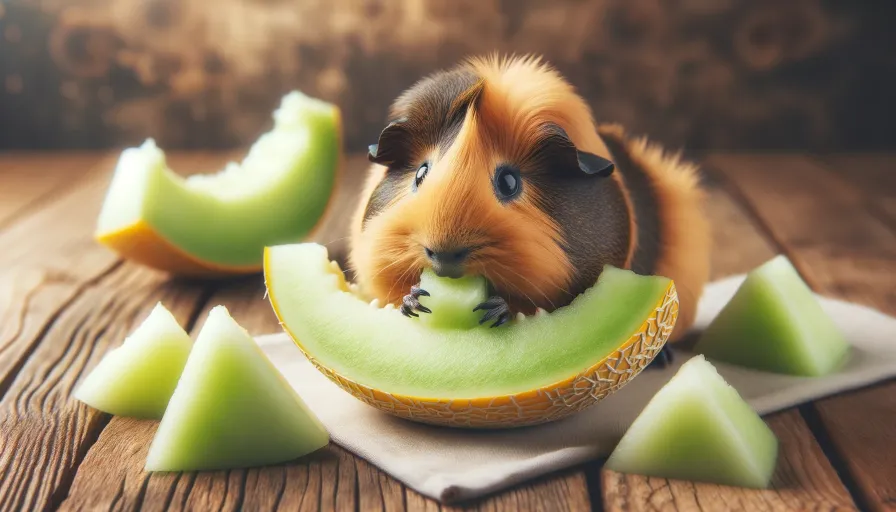
Before offering honeydew melon to your guinea pig, it’s essential to know how to prepare and serve it safely.
Follow these steps to ensure your furry friend can enjoy this delicious treat without any harm.
- Wash the honeydew melon thoroughly under running water to remove any dirt or pesticides that may be present on the skin.
- Cut the melon in half and scoop out the seeds from the center. Guinea pigs should not consume the seeds as they can be a choking hazard.
- Slice the melon into small, bite-sized cubes. Remember, guinea pigs have small mouths, so it’s best to cut the pieces into manageable sizes.
- Place the honeydew melon cubes in a clean dish or directly in your guinea pig’s food bowl.
When serving honeydew melon, ensure that it is fresh and ripe. This will not only make it more appealing to your guinea pig but also ensure they receive the maximum nutritional benefits.
Always offer honeydew melon as a treat and not as a substitute for their regular diet.
Tips for Serving Honeydew Melon
Here are some additional tips to consider when serving honeydew melon to your guinea pig:
- Start by offering a small piece of honeydew melon to your guinea pig and observe their reaction. If they enjoy it and show no signs of digestive upset, you can continue to include it in their diet occasionally.
- Offer honeydew melon once a week as a special treat. Remember, moderation is key to prevent health issues related to high sugar content.
- Remove any uneaten melon from your guinea pig’s cage after a few hours to avoid spoilage and attracting pests.
Remember to provide a diverse diet for your guinea pig, including a variety of fruits, vegetables, hay, and pellets. This will ensure they receive all the necessary nutrients for optimal health and wellbeing.
| Honeydew Melon | Vitamin C (mg) | Vitamin A (IU) | Potassium (mg) |
|---|---|---|---|
| 1 cup (approx. 170g) | 61.4 | 2946 | 388 |
Introducing Honeydew to a Guinea Pig’s Diet
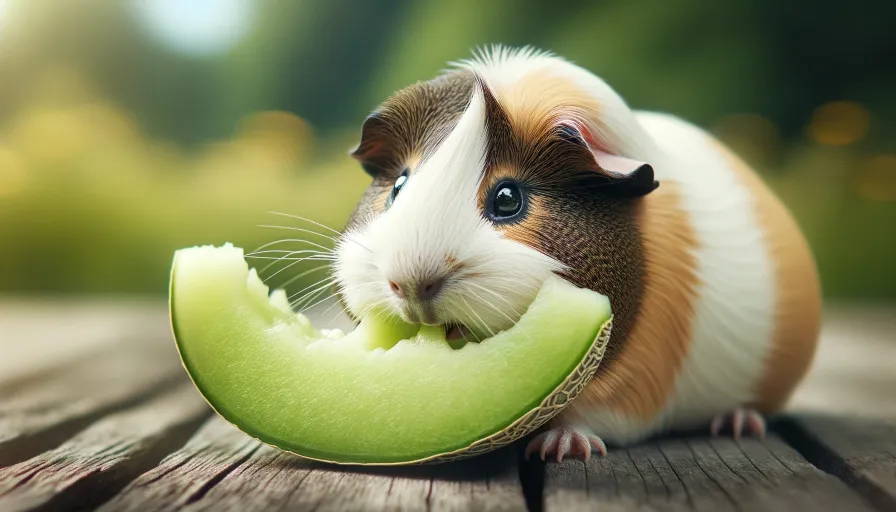
When introducing honeydew melon to your guinea pig’s diet, it’s important to do so gradually and observe their response.
Guinea pigs have sensitive digestive systems, so sudden changes in their diet can lead to stomach upset. Start by offering a small piece of honeydew melon and monitor how your guinea pig reacts.
The serving size for honeydew melon should be a small cube, about the size of a grape. This will help prevent overfeeding and ensure that your guinea pig is getting a balanced diet.
Offer honeydew melon as a treat once a week, alongside their regular meals of hay, pellets, and vegetables.
It’s also crucial to wash the honeydew melon thoroughly before serving it to your guinea pig. This will remove any pesticides or surface dirt that could be harmful to their health.
Additionally, be sure to remove the seeds as they can pose a choking hazard.
| Honeydew Melon Serving Guidelines: | |
|---|---|
| Size: | Small cube (about the size of a grape) |
| Frequency: | Once a week |
| Preparation: | Wash thoroughly, remove seeds |
Remember, while honeydew melon can be a tasty and nutritious treat for guinea pigs, it should be offered in moderation to avoid potential health issues.
Maintaining a balanced diet that includes a variety of fruits, vegetables, hay, and pellets is key to keeping your guinea pig healthy and happy.
Other Fruits for Guinea Pigs
In addition to honeydew melon, there are other fruits that can be a healthy and enjoyable part of a guinea pig’s diet.
These fruits provide essential vitamins and minerals, adding variety to their meals. Here are some safe fruits for guinea pigs:
- Apples: Remove the seeds and core, then slice the apple into small pieces.
- Strawberries: Offer these in moderation as a sweet treat.
- Blueberries: High in antioxidants, these can be fed as an occasional treat.
- Grapes: Cut them into halves or quarters to prevent choking hazards.
- Oranges: Rich in vitamin C, these can be enjoyed by guinea pigs, but the acidity may cause some digestive upset, so offer in small quantities.
- Pears: Remove the seeds and slice the pear into bite-sized portions.
When introducing these fruits to your guinea pig’s diet, start with small portions and monitor their reaction. If any signs of digestive issues occur, such as diarrhea or upset stomach, discontinue feeding that particular fruit.
Remember, while fruits provide important nutrients, they should be given in moderation to prevent health issues.
Too much sugar can lead to obesity, diabetes, and other health complications. Always prioritize a balanced diet for your guinea pig, consisting of hay, pellets, and vegetables, alongside a limited amount of fruit.
| Fruit | Serving Size | Frequency |
|---|---|---|
| Honeydew Melon | Small cube | Once a week |
| Apples | Small pieces | A few times a week |
| Strawberries | 1-2 strawberries | Occasional treat |
| Blueberries | 3-4 blueberries | Occasional treat |
| Grapes | Halves or quarters | Occasional treat |
| Oranges | Small portions | Occasional treat |
| Pears | Sliced into bite-sized pieces | A few times a week |
A Balanced Diet for Guinea Pigs
While fruits like honeydew melon can be a tasty addition to a guinea pig’s diet, it’s crucial to provide a well-rounded and balanced meal plan.
Guinea pigs have specific dietary requirements to ensure their overall health and well-being. A balanced diet for guinea pigs consists of hay, pellets, vegetables, and a limited amount of fruits.
By incorporating these elements into their daily meals, you can help maintain their nutritional needs and prevent any potential health issues.
Hay: Guinea pigs should have unlimited access to fresh, high-quality hay. This is an essential part of their diet as it provides the necessary fiber to support their digestive system.
Timothy hay is a popular choice, but other types like orchard grass or meadow hay can also be suitable.
Pellets: Guinea pig pellets should be specifically formulated for their nutritional needs. Look for a high-quality brand that is rich in vitamin C, as guinea pigs cannot produce this vitamin on their own. Pellets should be given in moderation and be a small part of their overall diet.
Vegetables: Fresh vegetables are an important component of a guinea pig’s balanced diet. Leafy greens like spinach, romaine lettuce, and kale are excellent choices.
Other vegetables like bell peppers, carrots, and cucumbers can also be offered in small amounts. Introduce new vegetables gradually to monitor their reaction and avoid any digestive upsets.
Table: Recommended Vegetables for Guinea Pigs
| Vegetables | Serving Size | Frequency |
|---|---|---|
| Spinach | 1 cup | Every other day |
| Romaine Lettuce | 1 cup | Every day |
| Kale | 1/4 cup | Twice a week |
| Bell Peppers | 1/4 cup | Once a week |
| Carrots | 1 small carrot | Once a week |
| Cucumbers | 1/4 cup | Once a week |
Fruits: While fruits are a sweet treat for guinea pigs, they should only be given in moderation. Fruits like honeydew melon can be offered as a special treat once a week.
Ensure the fruit is washed thoroughly and remove any seeds or pits. The serving size should be a small cube to prevent overconsumption of sugar.
Other fruits that are safe for guinea pigs include apples, pears, and strawberries. Remember to introduce new fruits gradually and monitor their response.
Aiming for a balanced diet that includes hay, pellets, vegetables, and limited fruits will help ensure your guinea pig receives all the necessary nutrients for optimal health.
Consult with a veterinarian for specific dietary recommendations tailored to your guinea pig’s individual needs. By providing a well-rounded meal plan, you can keep your furry friend happy and healthy.
Potential Health Issues from Overfeeding Honeydew
Overfeeding honeydew melon to your guinea pig can lead to various health issues that should be avoided for their overall well-being.
While honeydew melon can be a tasty and nutritious treat for guinea pigs, it’s essential to remember that it is high in sugar.
Excessive consumption of sugary fruits can have detrimental effects on their health, including obesity, diabetes, and digestive problems.
Guinea pigs have sensitive digestive systems that are not designed to handle large amounts of sugar.
Overfeeding honeydew melon can lead to weight gain, which can put unnecessary strain on their bones and joints. Additionally, the high sugar content can disrupt their gut flora, leading to digestive issues such as diarrhea or bloating.
To prevent these health issues, it is crucial to offer honeydew melon to guinea pigs in moderation. A small cube of honeydew melon once a week is sufficient as a treat.
It’s important to note that this serving size may vary depending on the size and age of your guinea pig, so it’s best to consult with a veterinarian for specific recommendations.
| Health Issues | Prevention Tips |
|---|---|
| Obesity | Limit the amount of honeydew melon and other sugary fruits in their diet. Focus on providing a balanced diet with a variety of vegetables, hay, and pellets. |
| Diabetes | Avoid feeding honeydew melon to guinea pigs with a history of diabetes or elevated blood sugar levels. Monitor their overall sugar intake and consult with a veterinarian for appropriate dietary guidelines. |
| Digestive Problems | Introduce honeydew melon gradually into their diet to allow their digestive system to adjust. Monitor their stool consistency and behavior for any signs of digestive issues. |
In addition to monitoring their honeydew melon consumption, it’s important to maintain a balanced diet for guinea pigs.
Offer a variety of other fruits and vegetables to ensure they receive a wide range of essential nutrients. Remember to prioritize hay, pellets, and fresh vegetables as the main components of their daily diet, with sugary fruits like honeydew melon serving as occasional treats.
Monitoring and Adjusting Honeydew Consumption
It’s essential to monitor your guinea pig’s consumption of honeydew melon and make adjustments to ensure their diet remains healthy and balanced.
While honeydew can be a tasty and nutritious treat for guinea pigs, it is high in sugar and should only be offered in moderation.
Too much sugar can lead to weight gain, obesity, and even diabetes in guinea pigs. To prevent these potential health issues, it’s important to carefully monitor their intake of honeydew melon.
When introducing honeydew melon to your guinea pig’s diet, start with a small piece and observe their reaction.
If they enjoy it and have no adverse effects, you can continue offering it as an occasional treat. The serving size should be kept small, typically a small cube, to avoid overconsumption.
It’s recommended to offer honeydew melon once a week or less frequently to maintain a balanced diet.
In addition to monitoring their honeydew melon consumption, it’s crucial to provide a variety of other fruits and vegetables in their diet.
This ensures they receive a wide range of essential nutrients and prevents them from becoming too reliant on one type of food.
Fresh hay and high-quality pellets should also be a staple in their diet to provide the necessary fiber and vitamins.
| Fruit | Serving Size | Frequency |
|---|---|---|
| Honeydew Melon | Small cube | Once a week |
| Strawberries | 1-2 berries | 2-3 times a week |
| Blueberries | 3-4 berries | 1-2 times a week |
Remember to thoroughly wash the honeydew melon to remove any pesticides before offering it to your guinea pig.
Avoid feeding them the seeds, as they can pose a choking hazard. By monitoring their honeydew melon consumption and providing a balanced diet, you can help ensure that your guinea pig remains healthy and happy.
Conclusion
Honeydew melon can be a nutritious treat for guinea pigs, but it should be offered in moderation as part of a balanced diet.
Guinea pigs can safely consume the flesh and skin of honeydew melon, but they should not be fed the seeds.
This sweet fruit is packed with essential vitamins and minerals, including vitamin C, vitamin A, and potassium, which contribute to a guinea pig’s overall health.
However, it’s important to note that honeydew melon is high in sugar, so it should only be given occasionally to avoid potential health issues such as obesity and diabetes.
To ensure the safety of your furry friend, it’s crucial to wash the melon thoroughly and remove any pesticides before offering it to your guinea pig.
When introducing honeydew melon to your guinea pig’s diet, start with a small piece and closely monitor their reaction.
The serving size should be a small cube, and it should be offered as a treat once a week. Remember, moderation is key.
In addition to honeydew melon, it’s important to provide a variety of other fruits and vegetables as part of a balanced diet for guinea pigs.
Alongside these fresh treats, guinea pigs should also have access to hay and pellets to maintain their overall nutrition.
By offering a diverse range of foods, you can ensure that your guinea pig stays healthy and happy.
FAQ
Can guinea pigs have honeydew?
Yes, guinea pigs can safely eat honeydew melon in moderation.
What are the nutritional benefits of honeydew for guinea pigs?
Honeydew melon is a nutritious treat for guinea pigs as it contains essential vitamins and minerals like vitamin C, vitamin A, and potassium.
Are there any risks of feeding honeydew to guinea pigs?
Honeydew melon is high in sugar, so it should only be offered occasionally to avoid health issues such as obesity and diabetes.
How often can guinea pigs have honeydew?
Guinea pigs should have honeydew melon as a treat once a week, in a small cube serving size.
How should honeydew melon be prepared and served to guinea pigs?
Honeydew melon should be washed thoroughly and any pesticides should be removed before feeding it to guinea pigs.
How should honeydew be introduced to a guinea pig’s diet?
Start with a small piece and monitor their reaction, gradually incorporating it into their regular meals.
What are other fruits safe for guinea pigs to eat?
Other safe fruits for guinea pigs include apples, strawberries, and blueberries.
What is a balanced diet for guinea pigs?
Guinea pigs require a balanced diet consisting of hay, pellets, vegetables, and a variety of fruits.
What are potential health issues from overfeeding honeydew?
Overfeeding honeydew melon can lead to obesity, diabetes, and other related health concerns.
How should honeydew consumption be monitored and adjusted?
Regularly assess a guinea pig’s health and adjust their diet accordingly, including their honeydew melon consumption.

